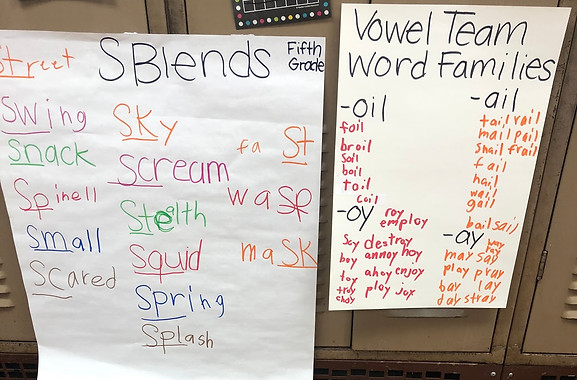Natasha Spinell
Certified PreK-3
Photographs
Here are some anchor charts that I created with my students as a Title I teacher. These anchor charts were made with the students and were added to and used as references throughout the school year. The top examples show anchor charts where students were asked to provide words to fit phonics patterns or definitions of genres that we had discussed. The bottom examples show our routines for dictation and word building activities. Having these charts available for students to refer back to made transitions smoother, kept students on task, and reminded students of previously learned information.




Here are some of my previous students enjoying a listening center and story board pieces that I had purchased through Donors Choose. I was able to have numerous projects funded to benefit my students. I also ran a professional development meeting about Donors Choose for my colleagues with the other preschool teacher in the building. I also created a presentation for other staff members to view as well.




Here is an example of a newsletter that I would create for families each week. I would place the newsletter in my students' folders, on the preschool bulletin board, and on Class Dojo to ensure that families were informed about what we were doing in the classroom.

Here is an example of a whole class behavior reward system that I used in my prekindergarten classroom. Although I had not created this reward system, implementing it was something that I did on my own. The other teachers on my team chose not to use this idea. I believe that it ensured that students in my classroom were praised more often and felt as though they were a part of a classroom community.

Here are examples of two classroom management tools that I implemented in the classroom in which I student taught. The first picture shows unifix cubes, which we referred to as "blurt cubes". A "blurt" is when a student shouts out in class without raising their hand, when it is not an emergency. Blurting was a big disruption issue we had in our class. If a student blurted, they lost one cube. If a student had at least one cube left at the end of the day, they would receive a small reward (a pencil, stamp, etc.). The number of cubes needed at the end of the day grew larger as time went on until students needed to have all five cubes left to earn a reward and eventually the cubes were no longer needed. The second picture shows a team reward system. The teams referred to the students' table groups. If a table was exceeding the classroom expectations, they received a point. This was a great tool for me because it reminded me to give students more verbal praise. This was also a good tool for students because it had them working together as a table to earn a reward (tickets that were used in a school store).


Here are two examples of anchor charts that I created during student teaching. The ideas for these anchor charts came from Pinterest. These particular anchor charts were related to literacy but I used anchor charts for each content area throughout the semester. I think that anchor charts make great visual aids for students when they are hung up in the classroom. They can serve as reminders and tools for students to refer back to.


Here are two photographs of me reading aloud to the kindergarten classroom in which I volunteered. I believe that read alouds are essential in any elementary classroom. Read alouds introduce students to new topics and ideas as well as vocabulary. I like to include sticky notes with questions to ask the students as I read the story so that they have an opportunity to discuss what we are reading with a partner. Having the sticky notes pre-made enables me to include higher level thinking questions and reminds me where I would like to pause in the story for the turn-and-talk sessions.


Here are examples of bulletin boards I have done in the education classrooms on the Ohio State University-Newark campus. I like to use seasons, book covers, and content area standards as inspiration. For example, the moon phases bulletin board is meant to be interactive so that students could place the correct move phase name next to the cut out of the moon phase.

